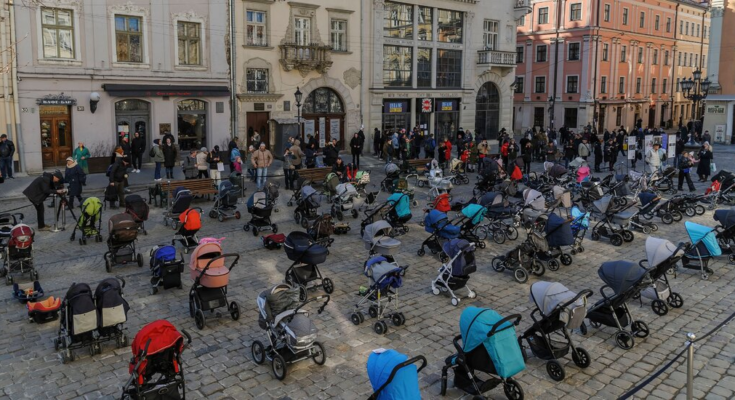KRAKOW, Poland — A peace activist in the western Ukrainian city of Lviv rolled 109 baby strollers into a square last week to represent the children who had been killed in the war with Russia. Hours later, the image was available to millions on their phones.
A little girl sheltering in a basement in Kyiv sang a haunting rendition of “Let it Go,” from the movie “Frozen,” and the clip sped around the world. A cellist performed a somber Bach suite on a street in Kharkiv, with debris and the windowless facade of a damaged building serving as his backdrop, and thousands watched.
These heart-wrenching glimpses of life in Ukraine since the Russian invasion have become powerful ammunition in an information war playing out on social media. For some, the messaging has become a crucial battleground complementing the Ukrainian military’s performance on the physical front lines, as images and information ripple out on Instagram, Facebook, Telegram and TikTok.
“We are experiencing the war very viscerally through social media feeds,” said Emerson Brooking, a resident senior fellow at the Atlantic Council, a Washington-based international-affairs think tank. “The transformation of Ukraine into a nation at war is just stark. And so it has especially resonated with Western audiences.”
Social media has long been a place where activists organize and share news, as well as a place to recruit fighters or seed disinformation. But in this battle, the proliferation of pictures showing the human toll of the war has helped Ukraine project an image of a country of stalwart survivors with the moral high ground, while casting Russia as a merciless aggressor — an impression reinforced by global condemnation and sanctions.
Mr. Brooking said that Ukraine had an additional advantage because Russia had not engaged in the same level of disinformation as it has in the past, in part because the government in Moscow has denied the extent of the war.
But Russian government accounts have actively questioned the veracity of verified Ukrainian civilian accounts appearing on social media.
Those efforts have only deepened Anastasiya Magerramova’s determination to show the world the devastation in Ukraine. Ms. Magerramova, 27, press secretary for the Okhmatdyt pediatric hospital in Kyiv, said she feels that she is fighting her own battle — a struggle for truth alongside the conflict among soldiers — as her compatriots take up arms.
Ms. Magerramova and a handful of colleagues have documented the civilians streaming in with injuries. She and some others have moved into the hospital, sleeping in the wards and working around the clock, phones in hand and cameras at the ready. They post the images on Instagram, Facebook, and Telegram with detailed descriptions of what happened to those shown in the pictures.
“I feel that my job is important, it is also like a weapon,” she said. “I want to show the people the consequences of this war: poor children with shrapnel in their legs, their arms, in their heads. It’s not OK, it shouldn’t be like this.”
The hospital’s social media accounts have become a running documentation of the civilian toll, showing — often in excruciating detail — the suffering of those caught up in the war.
On Saturday, Ms. Magerramova posted a photo on social media of a young mother, Olga, who had used her body to shield her baby from shelling. The family’s travails — the father was also injured — instantly reverberated around the world, picked up first by the government, then by activists, Ukrainian news media and later, international outlets.
The personal stories keep Ms. Magerramova’s phone ringing as she fields calls from journalists around the world.
Civil society groups and humanitarian organizations based inside and outside of Ukraine have also played a vital role in amplifying voices, turning into a sort of activist army to verify and disseminate information.
Marta Barandiy set up Promote Ukraine, a nongovernmental media hub, in 2014, when Russia annexed Crimea from Ukraine. When the full-scale invasion began in February, the group’s volunteer ranks swelled and it expanded its online presence.
April 16, 2022, 8:30 p.m. ET
Dozens now volunteer, spending their days posting information online, some working remotely from Europe and some sharing updates from Ukrainian cities under siege.
“We are trying to be a deep communication platform for Ukrainians who are in Ukraine, as well as for Ukrainians who have fled Ukraine who have stories to share,” Ms. Barandiy said. Her group translates reports from those on the ground and from government sources into English, and this week began staging news conferences to further amplify the stories.
Some of her group’s volunteers are working out of a Ukrainian civil society hub recently opened in a European Parliament building in Brussels.
Maryna Yaroshevych, head of advocacy for Promote Ukraine, said she thought the power of some of the images had already contributed to public pressure for sanctions on Russia.
“They are opening the hearts of Europeans and people around the world,” she said. “This way, average people can pressure politicians to intervene and do something.”
While some information sharing is coordinated, many of the most wrenching images have spread organically, Mr. Brooking of the Atlantic Council said.
There have also been a number people aggregating details shared on Telegram accounts run by the government and written in Ukrainian, and then sharing them on Twitter in English, putting them in front of the eyes of thousands of international journalists.
Russia-Ukraine War: Key Developments
“There are definitely funnels which are releasing more raw war footage into Twitter,” Mr. Brooking said. “So it is coordinated in that fashion, but after those images are released, my sense is really viral momentum is based more on the images themselves.”
Because the fighting has made some parts of Ukraine inaccessible to all but a handful of journalists, the personal tales shared by civilians on social media have become even more compelling.
Nadezhda Sukhorukova, who managed to escape the besieged southern port of Mariupol and is now near Odessa, a city further to the west, with her son, has described living a “hell” as the Russians shelled Mariupol incessantly. For weeks, she hid out in a basement, only daring to venture out for necessities.
“A neighbor said that God left Mariupol. He was afraid of everything he saw,” Ms. Sukhorukova wrote in a series of Facebook posts after her escape late last week.
The only international journalists who had remained in recent weeks were a team from The Associated Press. But they were forced to flee last week after appearing on a Russian hit list.
So Ms. Sukhorukova’s account, like the other sporadic retellings that have filtered out, has been crucial to conveying the devastation in Mariupol.
“The dead lie in the entrances, on the balconies, in the yards,’’ Ms. Sukhorukova wrote in one of the posts shared thousand of times.
She said in an interview by phone that she did not expect her story to be of interest to anyone and had composed the ideas in her head when the internet was cut “just to not go crazy.” Her first posts were to tell friends that she was alive.
“Once, I thought that if I write, everything will change,” she said. “But, unfortunately, no one is taking people out of the city, no one is closing the sky.”
Joan Donovan, research director at Harvard’s Shorenstein Center on Media, Politics and Public Policy who has studied how information spreads online, said that while social media sometimes allows disinformation to thrive, it can also be an amplifier of unheard voices.
She said she hoped to see the focus remain on the accounts streaming out from Ukraine, particularly if and when the Western media’s focus on the war wanes.
“It’s going to be even more important that people document and share their direct experiences of the war,” she said, “and that concerned audiences don’t look away.”
Nataliia Novosolova contributed reporting from Vinnytsia, Ukraine.



